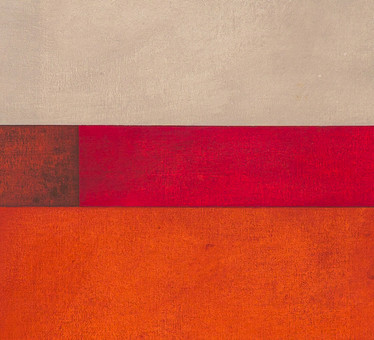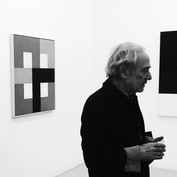Adolfo Estrada

Buenos Aires, Argentina, 1942
In 1918, a group of artists including Piet Mondrian, Theo Van Doesburg and Georges Vantongerloo wrote the First De Stijl Manifesto, declaring the existence of a decisive artistic struggle to overcome the modern dichotomy between individual and world. Rectangular planes, pure colors and the predominance of vertical and horizontal movement mark the first moment of this avant-garde committed to bringing to light a new awareness of time, founded on the synthetic balance of the individual and the universal.
The work of Argentine painter Adolfo Estrada closely dialogues with these ideas, involving a similar aura. An artist with an admirable sense of investigation and consistency, Estrada takes the rectangle as the primordial geometric form both in his paintings and in his three-dimensional works, including his architectural projects. Canvases such as Painting 0380 (2002), Painting 0444 (2002) and the entire series of Quartorze Estações (1995) have their own soul that originates in the natural grooves of the wood or paper that compose them, in the gestural marks of the application of color and in the vibration of compositions sometimes more serene, sometimes more syncopated, thus emitting a pictorial sound that favors an environment of reduced temporality.
Architect Carlos Martí Arís notes that Adolfo Estrada works with “spatial archetypes”, just as Maliévitch and Mondrian did. In addition to the canvases, the artist’s three-dimensional works also reveal his propensity for the archetypal, symbolic realm. Two rectangles intersect, one horizontally and the other vertically: an evocation of the small carved wooden altars that establish the place of the sacred in the midst of the secularity of the home. However, the various altars of form executed by Estrada throughout 2002, for example, emanate a receptivity that certainly distinguishes them from the solipsistic and even terrifying presence of Maliévitch’s Black Square, exposed in 1915 as a traditional Russian religious icon.
It is in this way that Adolfo Estrada’s work seems to approach Rothko, designing works capable of both enjoying and establishing an environment of silence and distance without, however, completely isolating the individual in helplessness. This seems to be the meaning taken by works such as the mural at the Hospital Universitário de Santiago de Compostela (2002) and the recent Chapel of San Leonardo (2021), both made in Spain. Temporality, spatiality and sonority thus form the aesthetic amalgamation of Adolfo Estrada’s works, giving each of them a body in the world that is unique and endowed with a powerful structuring force: a synthesis of the individual and the universal.
GG
Exhibition "Line, Color and Movement"
We present Line, Color and Movement. Dan Galeria's new online collection exhibition.
